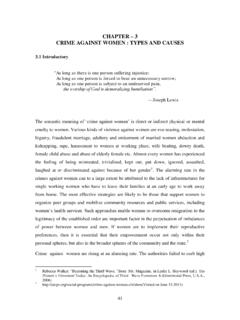Transcription of Intelligent Heat Detectors - Edificios Inteligentes
1 TM. EDWARDS SYSTEMS TECHNOLOGY ANALOG ADDRESSABLE INITIATING DEVICES. Compatibility ! | QS4/QS1 | EST2 | EST3 | IRC-3/FCC. Intelligent heat Detectors Models SIGA-HFS & SIGA-HRS. Features Note: Some features described here may not be supported by all control systems. Check your control panel's Installation and Operation Guide for details. " 70 foot ( meter) spacing MEA. " 15oF (9oC)/min rate-of-rise/135oF (57oC) ft. and 135oF (57oC). fixed temperature type S. CHINA. " Intelligent detector c/w integral microprocessor Application Notes Available " Non-volatile memory " Automatic device mapping The information stored in the detector's memory includes: " Electronic addressing - detector type, serial number, and address - date of manufacture, hours of operation, and last maintenance date . " Identification of defective Detectors - current detector (ambient) temperature values " Twin RED/GREEN status LEDs - current detector sensitivity and environmental compensation " Standard, relay, fault isolator, and audible mounting bases values " Designed and manufactured to ISO 9001 standards - number of recorded alarms and troubles.
2 - time and date of last alarm . - analog signal patterns just before the last alarm . Description - most recent trouble code logged by the detector 32 possible EST's Signature Series Model SIGA-HFS and SIGA-HRS Intelligent trouble codes may be used to diagnose faults. heat Detectors gather analog information from their fixed temperature and/or rate-of-rise heat sensing elements and converts In the unlikely event that an unwanted alarm does take place, the it into digital signals. The detector's on-board microprocessor control panel's history file can be called up to help isolate the measures and analyzes these signals. It compares the information problem and prevent it from happening again. to historical readings and time patterns to make an alarm decision. Automatic Device Mapping - The loop controller learns where Digital filters remove signal patterns that are not typical of fires.
3 Each device's serial number address is installed relative to other Unwanted alarms are virtually eliminated. devices on the circuit. This mapping feature provides supervision The microprocessor in each detector provides four additional of each device's installed location to prevent a detector from benefits - Self-diagnostics and History Log, Automatic Device being reinstalled (after cleaning etc.) in a different location from Mapping, Stand-alone Operation and Fast, Stable Communication. where it was originally. The history log for the detector remains relevant and intact regardless of its new location. Self-diagnostics and History Log - Each Signature Series detector constantly runs self-checks to provide important maintenance The Signature Series Data Entry Program also uses the mapping information. The results of the self-check are automatically updated feature.
4 With interactive menus and graphic support, the wired and permanently stored in the detector's non-volatile memory. circuits between each device can be examined. Layout or as- This information is accessible for review any time at the control built drawing information showing wire branches (T-taps), device panel, PC, or by using the SIGA-PRO Signature Program/Service types and their address are stored on disk for printing hard copy. Tool. This takes the mystery out of the installation. The preparation of as- built drawings is fast and efficient. EST3 only. Retrievable with SIGA-PRO programming tool. EDWARDS SYSTEMS TECHNOLOGY. SALES: SARASOTA, FL 941-739-4638; FAX 941-727-1214 CANADA SALES: OWEN SOUND, ON 519-376-2430; FAX 519-376-7258. INTERNATIONAL SALES: 905-270-1711; FAX 905-270-9553 CORPORATE HEADQUARTERS: CHESHIRE, CT MANUFACTURING: PITTSFIELD, ME.
5 Issue 5 Literature Sheet #85001-0243 Page 1 of 4. Device mapping allows the Signature loop controller to discover: Specifications Table - unexpected additional device addresses Catalog Number SIGA-HFS SIGA-HRS. - missing device addresses heat Sensing Fixed Fixed & Temperature/. - changes to the wiring in the circuit. Element Temperature Rate-of-Rise Stand-alone Operation - A decentralized alarm decision by the Alarms at 135 F (57 C). Alarms at 135 F. detector is guaranteed. On-board intelligence permits the detector Alarm Point Ambient or Temp. increase (57 C) Ambient to operate in stand-alone mode. If loop controller CPU communi- above 15 F (9 C) per min. cations fail for more than four seconds, all devices on that circuit UL Listed 70 feet ( meters) center to center spacing go into stand-alone mode. The circuit acts like a conventional Detector Spacing alarm receiving circuit.
6 Each detector on the circuit continues to Operating and Operating Temp: 32 F to 100 F (0 C to 38 C). collect and analyze information from its surroundings. Both the Storage Storage Temp: -4 F to 140 F (-20 C to 60 C). SIGA-HRS and SIGA-HFS Detectors alarm if the ambient tempera- Environment Humidity: 0 to 93% RH, Non-Condensing ture increases to 135OF (57oC) or for the SIGA-HRS only, the Operating Voltage to Vdc (19 Vdc nominal). temperature increases at a rate exceeding 15oF (9oC)/minute. If the Quiescent: 45 A @ 19 V. detector is mounted to a relay base, the relay operates. Similarly, if Operating Alarm: 45 A @ 19V. it is mounted to an audible base, the on-board horn sounds. Current Emergency Stand-alone Alarm Mode: 18mA. Pulse Current: 100 A (100 msec). Fast Stable Communication - On-board intelligence means less information needs to be sent between the detector and the loop Construction &.
7 High Impact Engineering Polymer - White controller. Other than regular supervisory polling response, the Finish detector only needs to communicate with the control panel when it Compatible SIGA-SB Standard Base, SIGA-RB Relay Base, has something new to report. This provides very fast control panel Mounting Bases SIGA-IB Isolator Base, SIGA-AB Audible Base response time and allows a lower baud rate (speed) to be used for On-board Green LED - Flashes when polled communication on the circuit. The lower baud rate offers several On-board Red LED - Flashes when in alarm; Both advantages including: LED Operation LEDs - Glow steady when in alarm (stand-alone). Compatible Remote Red LED (model SIGA-LED). - less sensitivity to circuit wire characteristics Flashes when in alarm - less sensitivity to noise glitches on the cable Compatibility Use With: SIGNATURE Loop Controller - less emitted noise from the data wiring Address Uses one device address - twisted or shielded wiring is not required Requirements Electronic Addressing - The loop controller electronically ad- Agency Listings UL, ULC, MEA, CSFM.
8 Dresses each detector, saving valuable time during system commissioning. Setting complicated switches or dials is not required. Each detector has its own unique serial number stored in Installation its on-board memory. The loop controller identifies each device on the circuit and assigns a soft address to that device's serial Signature Series Detectors mount to North American 1-gang number. If desired, Detectors can be addressed using the SIGA- boxes, 3-1/2 inch or 4 inch octagon boxes, and to 4 inch square PRO Signature Program/Service Tool. electrical boxes 1-1/2 inches (38 mm) deep. They mount to European BESA and 1-gang boxes with mm fixing centers. Installation Spacing - The SIGA-HFS (fixed temperature) and the SIGA-HRS (fixed temperature/rate-of-rise combination) Intelligent heat Detectors are rated for installation at up to 70 foot ( meter).
9 Spacing. These Detectors may be installed in rooms with ambient temperatures up to 100oF (38oC). Status LEDs - Twin LEDs are visible from any direction. A flashing GREEN LED shows normal system polling from the loop controller. A flashing RED LED means the detector is in alarm state. Both LEDs on steady shows alarm state - stand-alone mode. Normal GREEN. LED activity is not distracting to building occupants, but can be quickly spotted by a maintenance technician. Quality and Reliability - EST Detectors are manufactured in North America to strict international ISO 9001 standards. All electronics utilize surface mount technology (SMT) for smaller size and greater immunity to RF noise. A conformal coating is used for humidity and corrosion resistance. All critical contacts are gold plated. Compatibility The SIGA-HFS and SIGA-HRS Detectors are compatible only with EST's Signature Loop Controller.
10 EDWARDS SYSTEMS TECHNOLOGY. Page 2 of 4 Literature Sheet #85001-0243 Issue 5. Application The table below shows six standard test fires used to rate the sensitivity of smoke and heat Detectors . The table indicates that no single sensing element is suited for all test fires. EST recommends that this detector be installed according to latest recognized edition of national and local fire alarm codes. Type of Detector SIGA-HRS and SIGA-HFS SIGA-PHS SIGA-IPHS. SIGA-PS Rate-of-Rise/ Photo heat Ion/Photo/ heat Test Fire SIGA-IS Ion Photo Fixed Temp. 3D 4D. Open Wood optimum unsuitable optimum very suitable optimum Wood Pyrolysis suitable optimum unsuitable optimum optimum Smouldering Cotton very suitable optimum unsuitable optimum optimum Poly Urethane Foam very suitable very suitable suitable very suitable optimum n-Heptane optimum very suitable very suitable optimum optimum Liquid Fire without Smoke unsuitable unsuitable optimum very suitable very suitable Typical Wiring The detector mounting bases will accept #18 AWG ( ), #16 ( ), #14 AWG ( ), and #12 AWG ( ) wire sizes.






